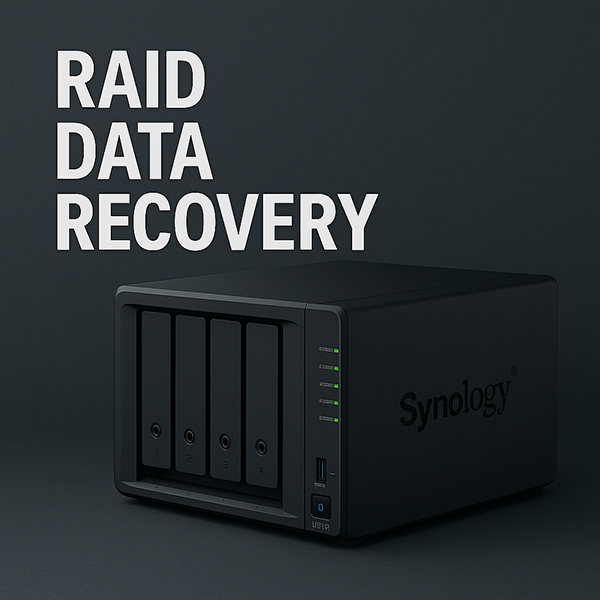RAID Data Recovery Services – Professional RAID Data Recovery Experts in London
When a RAID system fails, the data stored across multiple hard drives can quickly become inaccessible or corrupted. At our professional RAID data recovery service, we specialise in recovering data from all major RAID levels, ensuring fast, secure, and highly reliable results for businesses, IT departments, and individual users who need expert support.
At Data Recovery Lab, we offer a genuine no-recovery, no-fee RAID data recovery service, meaning you only pay when your critical data is successfully restored. All recovery processes are carried out locally in London using the latest forensic-grade tools, cleanroom technology, advanced diagnostic equipment, and industry leading techniques to maximise your chances of a full recovery.
✅ Free Collection
✅ Free Assessment
✅ Fixed Quotation
✅ Competitive Price
✅ No Hidden Costs
✅ No Recovery, No Fee!

Different Types of RAID Data Recovery
We provide professional RAID data recovery services for servers, workstations, and complex RAID arrays. No matter the configuration or operating system, our specialists are able to rebuild and recover data from failed RAID setups with precision and security.
RAID Data Recovery From Different Array Configuration Under The Following Operating Systems:
RAID-0 > Striped Array Data Recovery; RAID-1 > Mirror Array Data Recovery; RAID-5 > Parity Striped Array Data Recovery; RAID-6 > Double Parity Data Recovery; RAID-10 > Mirroring & Striping; JBOD > Spanned Disks Array Data Recovery

Our Proven Capabilities in RAID Data Recovery
- Recover data from QNAP RAID network attached units
- Recover data from Lenovo/EMC2 RAID network attached units
- Recover data from Synology RAID network attached units
- Recover data from NetGear RAID network attached units
- Recover data from Seagate RAID network attached units
- Recover data from Western Digital RAID network attached units
- Recover data from Buffalo RAID network attached units
- Recover data from Drobo RAID network attached units
- Recover data from LaCie RAID network attached units
- Recover data from Thecus RAID network attached units
- Recover data from Asustor RAID network attached units
- Recover data from TerraMaster RAID network attached units
- Recover data from Dell RAID storage systems
- Recover data from HP RAID storage systems
RAID Data Recovery: What are the different RAID levels we can recover from?
RAID”, (short for Redundant Array of Inexpensive Disks) defining six RAID levels. Each level is a different way to spread data across multiple drives.
RAID Level 0 is not redundant, hence does not truly fit the “RAID” acronym. In Level 0, data is split across drives, resulting in higher data throughput. Since no redundant information is stored, performance is very good, but the failure of any disk in the array results in all data loss. This level is commonly referred to as striping.
RAID Level 1 is commonly referred to as mirroring with 2 hard drives. It provides redundancy by duplicating all data from one drive on another drive. The performance of a Level 1 array is slightly better than a single drive, but if either drive fails, no data is lost. This is a good entry-level redundant system, since only two drives are required.
RAID Level 4 stripes data at a block level across several drives, with parity stored on one drive. The parity information allows recovery from the failure of any single drive. The performance of a level 4 array is very good for reads (the same as level 0). Writes, however, require that parity data be updated each time. This slows small random writes, in particular, though large writes or sequential writes are fairly fast.
RAID Level 5 is commonly referred to as striping with distributed parity. RAID Level 5 is similar to level 4, but distributes parity among the drives. No single disk is devoted to parity. This can speed small writes in multiprocessing systems.
If you RAID box has failed and you have lost access to your data, speak to a RAID Data Recovery expert on 02075161077 first before any attempt in making changes to your RAID array. You cannot afford to make a mistake and destroy the chances of a good RAID full recovery.
RAID Data Recovery Process:
We will perform a set of RAID data recovery procedures which includes initial RAID recovery evaluation, where data recovery technicians carefully examine the array to diagnose the exact nature of the problem. During this time, they will also attempt to make an image of the failed hard drives. The RAID data recovery specialists will then extract the data from the image, and will work to piece the whole array together. If successful, they will restore your data onto the media of your choice.
RAID Data Recovery – Frequently Asked Questions
What should I do immediately after a RAID failure?
If your RAID system fails, avoid rebuilding or making configuration changes, as this can reduce the chances of successful recovery. We recommend powering down the system and seeking professional RAID data recovery advice as soon as possible.
Which types of RAID configurations can you recover data from?
We recover data from a wide range of RAID configurations used in servers, workstations, and NAS systems, including both standard and complex multi-disk arrays.
How long does RAID data recovery take?
Recovery time depends on the RAID level and failure type, but most cases are completed within a few working days.
Should I attempt to rebuild my RAID array?
No. Attempting a rebuild after a RAID failure can permanently damage data. We recommend powering down the system and seeking professional advice.
Related Services:
CONTACT DATA RECOVERY LAB Today
For a free consultation and diagnostic, contact our London team:
- Phone: 020 7516 1077
- Email: info@datarecovery.london
- Address: Euro House, 133 Ballards Lane, London, N3 1LJ
or use the buttons below to book an appointment:
Request a Quote Make an Appointment
